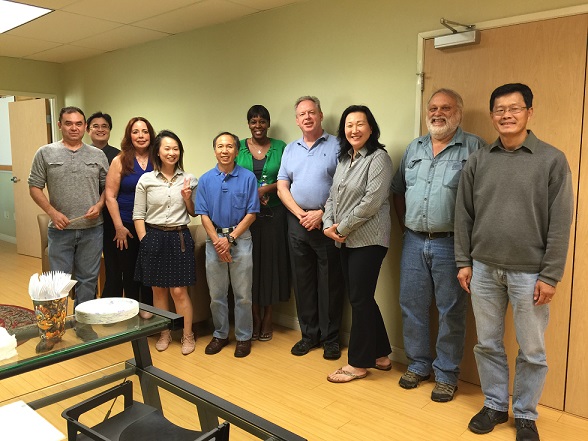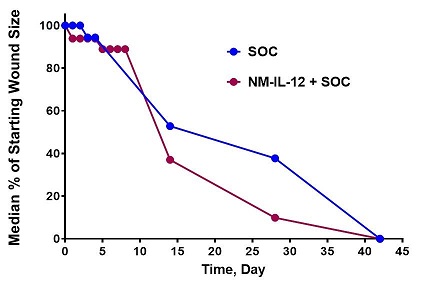Defense Medical Research and Development
A Novel, Broad Spectrum Anti-Infective that Provides Novel Regenerative Properties in Skin



Posted Feburary 27, 2018
Lena Basile, Ph.D., J.D., Neumedicines Inc.
A key modulator of the immune system,1,2 interleukin-12 (IL-12) has been extensively shown to demonstrate broad spectrum activity against bacterial, viral, fungal, and parasitic organisms implicated in both local and disseminated infections.3-5 Neumedicines, Inc., a company out of Pasadena, California, has demonstrated the potential wound healing properties of IL-12 in recent years. The novel implication of IL-12 in wound healing was initially tested in several rodent models of skin damage and repair where significant acceleration of wound healing and closure was observed.6,7 Neumedicines, Inc. began to investigate recombinant human interleukin-12 (rHuIL-12) in the hopes that it might help reduce morbidity, suppress wound infection, and accelerate wound healing of battle and traumatic wounds. If successful, rHuIL-12 would facilitate recovery, reduce amputation, and reduce the need for repetitive surgeries.
Once the potential of IL-12 as a wound healing agent was validated in animal models, Neumedicines, Inc. proceeded to complete three Phase 1 safety trials.8 The trials tested rHuIL-12 in 217 healthy human volunteers and contributed to the identification of a safe and well-tolerated dose, 12 micrograms, for further testing in other populations.
In their most recent advancement, Neumedicines, Inc. has successfully conducted a Phase 2a open-label, randomized study intended to compare the safety and tolerability of rHuIL-12 to standard of care (SOC) in patients with large, open surgical wounds following colostomy takedown, the reattachment of the colon to the rectum, which were allowed to heal by secondary intention. The study was also intended to establish a safe dose and dosing schedule for subsequent Phase 2b efficacy studies in patients. Study outcomes include (1) determining the pharmacokinetic (PK) profile, pharmacodynamic (PD) response and immunogenicity, as well as (2) evaluating accelerated wound healing properties via determination of time to 50 percent wound closure and wound closure rates at 14, 28, and 42 days after starting the study.

Dr. Lena Basile and her Research Team
Study subjects were consented, screened, and enrolled at the Surgical and Wound Care Clinic Barnes-Jewish (Saint Louis, Missouri), a center that specializes in treatment of wounds and treats some 500 patients a year. There have been 12 per-protocol patients that have now completed the study (8 subjects randomized to receive rHuIL-12 treatment + standard of care (SOC) and 4 subjects randomized to the SOC alone arm). There were no rHuIL-12-related adverse events reported. Also, 3 of the 8 rHuIL-12-treated patients had complete (100 percent) wound closure after 28 days, where end of the study was at 42 days, compared with 1 of the 4 SOC-treated patients. NM-IL-12 induced accelerated healing with wounds that were 18% larger than those in the SOC-treated patients, and in patients that were, on average, approximately 18 years older. In addition to determination of wound dimensions and extent of closure, wound photographs were assessed in a blinded and independent medical review. They showed accelerated healing in 3 of 8 rHuIL-12-treated patients as early as 14 days, but in only 1 of 4 SOC-treated patients. The PK/PD and immunogenicity data is currently being processed.
Neumedicines, Inc. envisions that rHuIL-12, with its excellent safety profile, will be a novel treatment for management of contaminated combat-related or trauma-induced wounds that will accelerate the closure, healing, and repair of the wound and prevent development of secondary infections.

Accelerated wound closure induced by NM-IL-12 (rHuIL-12) + SOC treatment (n=8 patients) as compared to Placebo + SOC (n=4 patients). Median percentage of wound size with time expressed against starting wound size.
This study was funded by the Defense Medical Research and Development Program managed by the Congressionally Directed Medical Research Programs and strategically aligned with the Military Infectious Diseases Research Program (award W81XWH-15-2-0009).
References:
1 Trinchieri G. 2003. Interleukin-12 and the regulation of innate resistance and adaptive immunity. Nat. Rev. Immunol. 3:133.
2 Bashyam H. 2007. Interleukin-12: A master regulator. J. Exp. Med. 204:969.
3 Gluzman-Poltorak Z, Mendonca SR, Vainstein V, Kha H, and Basile LA. 2014. Randomized comparison of single dose of recombinant human IL-12 versus placebo for restoration of hematopoiesis and improved survival in rhesus monkeys exposed to lethal radiation. J. Hematol. & Oncol. 7:31.
4 Romani, L, Puccetti, P, and Bistoni, F. 1997. Interleukin-12 in infectious diseases. Clin. Microbiol. Rev. 10:611-636.
5 Nguyen Q-T, Furuya Y, Roberts S, and Metzger DW. 2015. Role of Interleukin-12 in protection against pulmonary infection with methicillin-resistant Staphyloccocus aureus. Antimicrobial Agents and Chemo. 59:6308-6316.
6 Li J., Bower AJ, Vainstein V, Gluzman-Poltorak Z, Chaney EJ, Marjanovic M, Basile LA, and Boppart SA. 2015. Effect of recombinant interleukin-12 on murine skin regeneration and cell dynamics using in vivo multimodal microscopy. Biomed. Opt. Express. 6:4277-4287.
7 Neumedicines Internal Report. 2014. A summary of preclinical studies conducted to investigate the effect of subcutaneous and topical administration of recombinant murine interleukin-12 (rMuIL-12) upon cutaneous injury in rodent models of full thickness injury, radiation combined injury, and diabetic wound healing. NMWH10, 1-25.
8 Gokhale MS, Vainstein V, Tom J, Thomas S, Lawrence CE, Gluzman-Poltorak Z, Siebers N, and Basile LA. 2014. Single low-dose rHu-IL-12 safely triggers multilineage hematopoietic and immune-mediated effects. Exp. Hematol. Oncol. 3:11.Link:
Last updated Thursday, December 5, 2024














